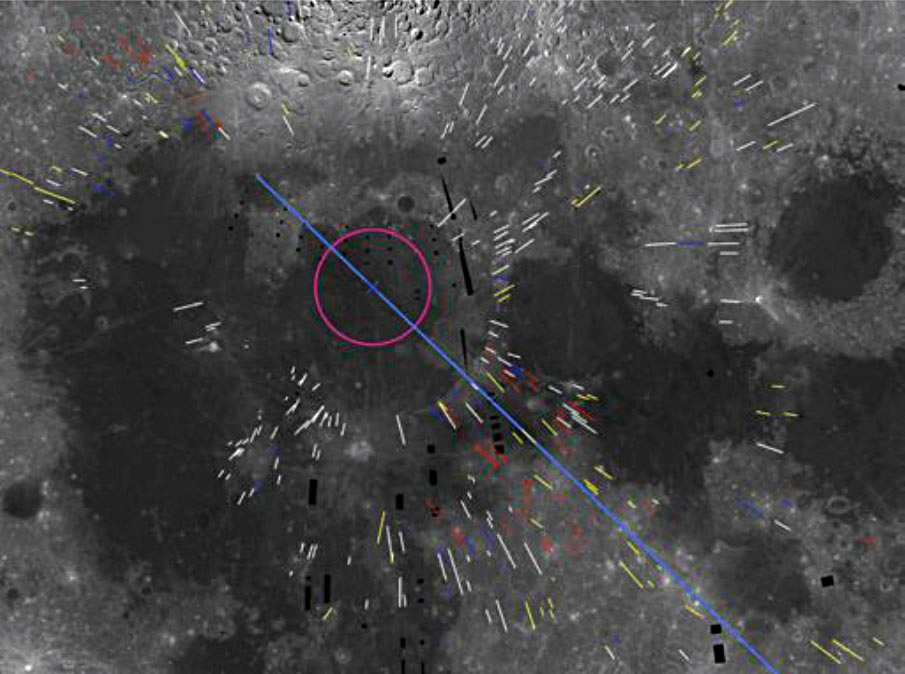Difference between revisions of "January 24, 2010"
(Created page with "__NOTOC__ =Radiating Linears= <!-- ws:start:WikiTextHeadingRule:1:<h1> --> <!-- ws:start:WikiTextLocalImageRule:16:<img src="/file/view/LPOD-Jan24-10.jpg/115...") |
|||
| (8 intermediate revisions by the same user not shown) | |||
| Line 1: | Line 1: | ||
__NOTOC__ | __NOTOC__ | ||
=Radiating Linears= | =Radiating Linears= | ||
| − | + | <!-- Start of content --> | |
| − | + | <!-- ws:start:WikiTextHeadingRule:1:<h1> --> | |
| − | + | <!-- ws:start:WikiTextLocalImageRule:16:<img src="/file/view/LPOD-Jan24-10.jpg/115300665/LPOD-Jan24-10.jpg" alt="" title="" /> -->[[File:LPOD-Jan24-10.jpg|LPOD-Jan24-10.jpg]]<!-- ws:end:WikiTextLocalImageRule:16 --><br /> | |
| − | <em>image by [mailto:tychocrater@yahoo.com Chuck Wood]</em><br /> | + | <em>image by [http://www.lpi.usra.edu/meetings/lpsc2010/pdf/2480.pdf Schultz & Papamarcos]. Blue line indicates the proposed trajectory axis. The purple circle corresponds to a 300km radius. Colors indicate convergence along the trajectory axis: white is near radial; yellow is downrange; blue is uprange; and red is sub-parallel to trajectory (from original caption).</em><br /> |
| + | <br /> | ||
| + | In 1893 Grove Karl Gilbert described [http://www.lpod.org/cwm/Timeline/1800s/1893-Gilbert.htm Imbrium sculpture] - the groves and ridges that radiate from the center of the basin. Gilbert considered the sculpture as evidence that a giant impact formed the basin, producing radiating fractures. The more modern view is that the sculpture is due to ejecta, not fractures. Concentration of the sculpture to the SE of the basin [http://www.lpi.usra.edu/meetings/lpsc1995/pdf/1626.pdf suggested] that Imbrium was formed by a 30° oblique impact with the projectile coming from the NW - the trajectory is marked by the long blue line. For a large oblique impact the rocks are ejected at different times and from different places. [http://www.lpi.usra.edu/meetings/lpsc2010/pdf/2480.pdf Pete Schultz and S. Papamarcos] have looked more closely at the grooves and secondary crater chains, mapping sculpture linears that are: (1) radial (white streaks) to the initial impact area (the purple circle), (2) converge (yellow) on the downrange area of excavation (between the purple circle and the Apennines), (3) converge on the uprange area (the Iridum side of the purple circle), and (4) parallel the projectile trajectory (red). This is a little confusing - read it 2-3 times. The downrange ejecta shows where the projectile first hit - within the purple circle. The parallel grooves show how wide the projectile was; Schultz and Papamarco deduce that the object that formed Imbrium was about 275 km in diameter. Ejecta didn't all come at one instant from one place. The failure of all Imbrium sculpture to be radial to one point provides more clues to the dynamics of big oblique impacts.<br /> | ||
| + | <br /> | ||
| + | <em>[mailto:tychocrater@yahoo.com Chuck Wood]</em><br /> | ||
<br /> | <br /> | ||
<strong>Related Links</strong><br /> | <strong>Related Links</strong><br /> | ||
| Line 10: | Line 14: | ||
<br /> | <br /> | ||
<hr /> | <hr /> | ||
| − | + | <table class="wiki_table"> | |
| − | + | <tr> | |
| − | + | <td> <!-- RemoveRevolverMaps --> | |
| − | ---- | + | <!-- RemoveRevolverMaps --> |
| − | + | </td> | |
| − | + | <p><b>Yesterday's LPOD:</b> [[January 23, 2010|The Roof of Another World]] </p> | |
| + | <p><b>Tomorrow's LPOD:</b> [[January 25, 2010|Early Rays of Understanding]] </p> | ||
| + | <!-- End of content --> | ||
| + | {{wiki/ArticleFooter}} | ||
Latest revision as of 19:45, 8 February 2015
Radiating Linears

image by Schultz & Papamarcos. Blue line indicates the proposed trajectory axis. The purple circle corresponds to a 300km radius. Colors indicate convergence along the trajectory axis: white is near radial; yellow is downrange; blue is uprange; and red is sub-parallel to trajectory (from original caption).
In 1893 Grove Karl Gilbert described Imbrium sculpture - the groves and ridges that radiate from the center of the basin. Gilbert considered the sculpture as evidence that a giant impact formed the basin, producing radiating fractures. The more modern view is that the sculpture is due to ejecta, not fractures. Concentration of the sculpture to the SE of the basin suggested that Imbrium was formed by a 30° oblique impact with the projectile coming from the NW - the trajectory is marked by the long blue line. For a large oblique impact the rocks are ejected at different times and from different places. Pete Schultz and S. Papamarcos have looked more closely at the grooves and secondary crater chains, mapping sculpture linears that are: (1) radial (white streaks) to the initial impact area (the purple circle), (2) converge (yellow) on the downrange area of excavation (between the purple circle and the Apennines), (3) converge on the uprange area (the Iridum side of the purple circle), and (4) parallel the projectile trajectory (red). This is a little confusing - read it 2-3 times. The downrange ejecta shows where the projectile first hit - within the purple circle. The parallel grooves show how wide the projectile was; Schultz and Papamarco deduce that the object that formed Imbrium was about 275 km in diameter. Ejecta didn't all come at one instant from one place. The failure of all Imbrium sculpture to be radial to one point provides more clues to the dynamics of big oblique impacts.
Chuck Wood
Related Links
Gilbert's 1893 paper
Yesterday's LPOD: The Roof of Another World
Tomorrow's LPOD: Early Rays of Understanding
COMMENTS?
Register, Log in, and join in the comments.



